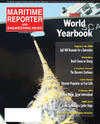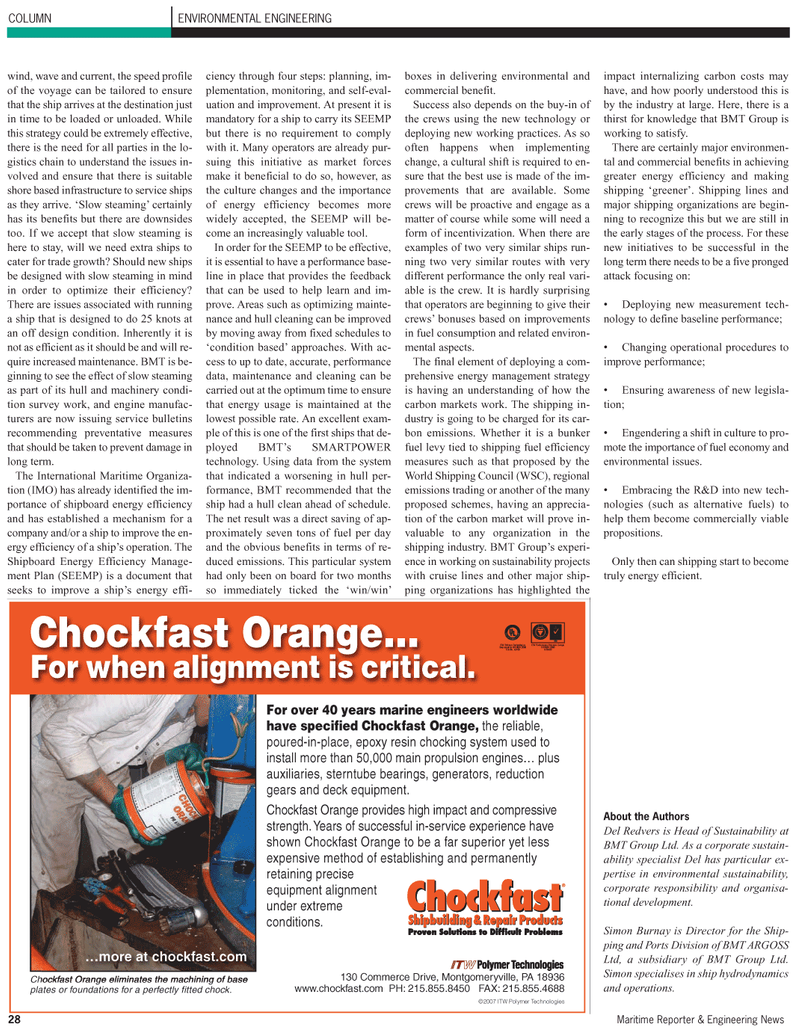
Page 28: of Maritime Reporter Magazine (June 2, 2010)
Read this page in Pdf, Flash or Html5 edition of June 2, 2010 Maritime Reporter Magazine
wind, wave and current, the speed profile of the voyage can be tailored to ensure that the ship arrives at the destination just in time to be loaded or unloaded. While this strategy could be extremely effective, there is the need for all parties in the lo- gistics chain to understand the issues in- volved and ensure that there is suitable shore based infrastructure to service ships as they arrive. ‘Slow steaming’ certainly has its benefits but there are downsides too. If we accept that slow steaming is here to stay, will we need extra ships to cater for trade growth? Should new ships be designed with slow steaming in mind in order to optimize their efficiency?
There are issues associated with running a ship that is designed to do 25 knots at an off design condition. Inherently it is not as efficient as it should be and will re- quire increased maintenance. BMT is be- ginning to see the effect of slow steaming as part of its hull and machinery condi- tion survey work, and engine manufac- turers are now issuing service bulletins recommending preventative measures that should be taken to prevent damage in long term.
The International Maritime Organiza- tion (IMO) has already identified the im- portance of shipboard energy efficiency and has established a mechanism for a company and/or a ship to improve the en- ergy efficiency of a ship’s operation. The
Shipboard Energy Efficiency Manage- ment Plan (SEEMP) is a document that seeks to improve a ship’s energy effi- ciency through four steps: planning, im- plementation, monitoring, and self-eval- uation and improvement. At present it is mandatory for a ship to carry its SEEMP but there is no requirement to comply with it. Many operators are already pur- suing this initiative as market forces make it beneficial to do so, however, as the culture changes and the importance of energy efficiency becomes more widely accepted, the SEEMP will be- come an increasingly valuable tool.
In order for the SEEMP to be effective, it is essential to have a performance base- line in place that provides the feedback that can be used to help learn and im- prove. Areas such as optimizing mainte- nance and hull cleaning can be improved by moving away from fixed schedules to ‘condition based’ approaches. With ac- cess to up to date, accurate, performance data, maintenance and cleaning can be carried out at the optimum time to ensure that energy usage is maintained at the lowest possible rate. An excellent exam- ple of this is one of the first ships that de- ployed BMT’s SMARTPOWER technology. Using data from the system that indicated a worsening in hull per- formance, BMT recommended that the ship had a hull clean ahead of schedule.
The net result was a direct saving of ap- proximately seven tons of fuel per day and the obvious benefits in terms of re- duced emissions. This particular system had only been on board for two months so immediately ticked the ‘win/win’ boxes in delivering environmental and commercial benefit.
Success also depends on the buy-in of the crews using the new technology or deploying new working practices. As so often happens when implementing change, a cultural shift is required to en- sure that the best use is made of the im- provements that are available. Some crews will be proactive and engage as a matter of course while some will need a form of incentivization. When there are examples of two very similar ships run- ning two very similar routes with very different performance the only real vari- able is the crew. It is hardly surprising that operators are beginning to give their crews’ bonuses based on improvements in fuel consumption and related environ- mental aspects.
The final element of deploying a com- prehensive energy management strategy is having an understanding of how the carbon markets work. The shipping in- dustry is going to be charged for its car- bon emissions. Whether it is a bunker fuel levy tied to shipping fuel efficiency measures such as that proposed by the
World Shipping Council (WSC), regional emissions trading or another of the many proposed schemes, having an apprecia- tion of the carbon market will prove in- valuable to any organization in the shipping industry. BMT Group’s experi- ence in working on sustainability projects with cruise lines and other major ship- ping organizations has highlighted the impact internalizing carbon costs may have, and how poorly understood this is by the industry at large. Here, there is a thirst for knowledge that BMT Group is working to satisfy.
There are certainly major environmen- tal and commercial benefits in achieving greater energy efficiency and making shipping ‘greener’. Shipping lines and major shipping organizations are begin- ning to recognize this but we are still in the early stages of the process. For these new initiatives to be successful in the long term there needs to be a five pronged attack focusing on: • Deploying new measurement tech- nology to define baseline performance; • Changing operational procedures to improve performance; • Ensuring awareness of new legisla- tion; • Engendering a shift in culture to pro- mote the importance of fuel economy and environmental issues. • Embracing the R&D into new tech- nologies (such as alternative fuels) to help them become commercially viable propositions.
Only then can shipping start to become truly energy efficient.
About the Authors
Del Redvers is Head of Sustainability at
BMT Group Ltd. As a corporate sustain- ability specialist Del has particular ex- pertise in environmental sustainability, corporate responsibility and organisa- tional development.
Simon Burnay is Director for the Ship- ping and Ports Division of BMT ARGOSS
Ltd, a subsidiary of BMT Group Ltd.
Simon specialises in ship hydrodynamics and operations. 28 Maritime Reporter & Engineering News
Chockfast Orange…
For when alignment is critical.
For over 40 years marine engineers worldwide have specified Chockfast Orange, the reliable, poured-in-place, epoxy resin chocking system used to install more than 50,000 main propulsion engines… plus auxiliaries, sterntube bearings, generators, reduction gears and deck equipment.
Chockfast Orange provides high impact and compressive strength.Years of successful in-service experience have shown Chockfast Orange to be a far superior yet less expensive method of establishing and permanently retaining precise equipment alignment under extreme conditions. 130 Commerce Drive, Montgomeryville, PA 18936 www.chockfast.com PH: 215.855.8450 FAX: 215.855.4688 ©2007 ITW Polymer Technologies
Chockfast Orange eliminates the machining of base plates or foundations for a perfectly fitted chock. …more at chockfast.com
ITW Polymer Technologies
Registered to ISO 9001:2000
File No. A3790
ITW Performance Polymers Europe
ISO 9001:2000
Q 05420
COLUMN ENVIRONMENTAL ENGINEERING

 27
27

 29
29
